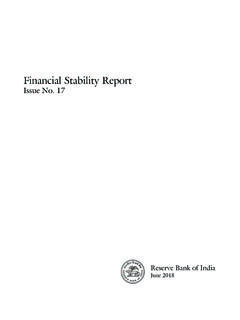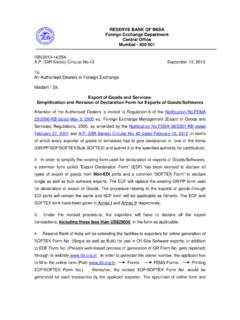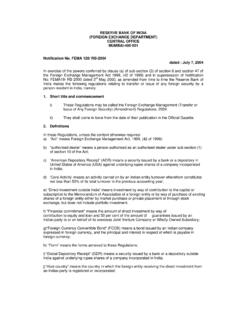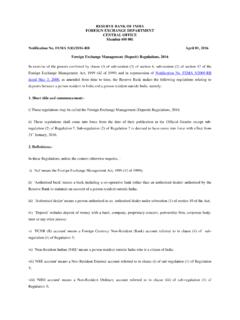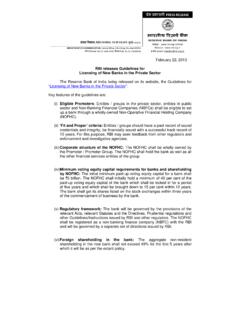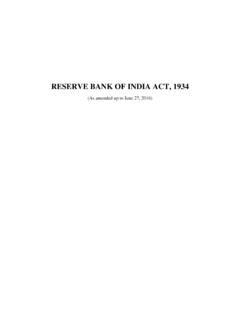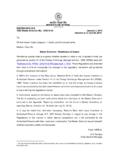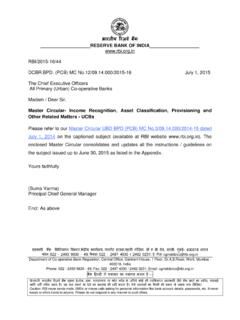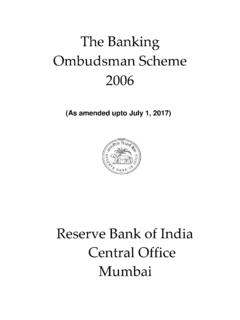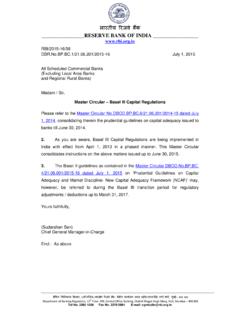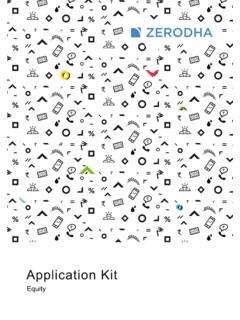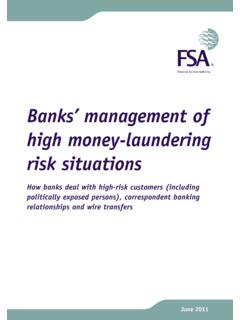Transcription of 'Know Your Customer' (KYC) Guidelines – Anti Money ...
1 RBI-2004-05 November 29, 2004 The Chief Executives of All Commercial BanksDear Sir,'Know Your Customer' (KYC) Guidelines Anti Money Laundering StandardsPlease refer to our circular DBOD. No. dated August 16, 2002on the Guidelines on 'Know Your Customer' norms. Banks were advised to follow certaincustomer identification procedure for opening of accounts and monitoring transactions of asuspicious nature for the purpose of reporting it to appropriate authority. These Know YourCustomer Guidelines have been revisited in the context of the Recommendations made by theFinancial Action Task Force (FATF) on Anti Money Laundering (AML) standards and onCombating Financing of Terrorism (CFT).
2 These standards have become the internationalbenchmark for framing Anti Money Laundering and combating financing of terrorism policies bythe regulatory authorities. Compliance with these standards both by the banks/financialinstitutions and the country have become necessary for international financial Guidelines based on the Recommendations of the Financial Action Task Force and thepaper issued on Customer Due Diligence(CDD) for banks by the Basel Committee on BankingSupervision, with indicative suggestions wherever considered necessary are enclosed. Banksare advised to ensure that a proper policy framework on Know Your Customer and Anti-MoneyLaundering measures is formulated and put in place with the approval of the Board within threemonths of the date of this circular.
3 It may also be ensured that banks are fully compliant withthe provisions of this circular before December 31, While preparing operational Guidelines banks may keep in mind the instructions issued in termsof our circular BC. dated May 12,2004 wherein bankswere advised to treat the information collected from the customer for the purpose of opening ofaccount as confidential and not divulge any details thereof for cross selling or any otherpurposes. Banks may, therefore, ensure that information sought from the customer is relevant tothe perceived risk, is not intrusive, and is in conformity with the Guidelines issued in this other information from the customer should be sought separately with his /her consent andafter opening the Banks should continue to ensure that any remittance of funds by way of demand draft.
4 Mail/telegraphic transfer or any other mode and issue of travelers cheques for value of Rupees fiftythousand and above is effected by debit to the customer s account or against cheques and notagainst cash Banks should ensure that the provisions of Foreign Contribution and Regulation Act, 1976wherever applicable are adhered to These Guidelines are issued under Section 35A of the Banking Regulation Act, 1949 and anycontravention of or non-compliance with the same may attract penalties under the relevantprovisions of the Once the policy framework is ready and implemented by a bank, the instructions issued videthis circular will supersede all instructions issued on Know Your Customer and Anti-MoneyLaundering measures till faithfully,( Prashant Saran)Chief General ManagerEncl: As above3 Guidelines on Know Your Customer normsAndAnti- Money Laundering Measures 'Know Your Customer' Standards1.
5 The objective of KYC Guidelines is to prevent banks from being used, intentionally orunintentionally, by criminal elements for Money laundering activities. KYC procedures also enablebanks to know/understand their customers and their financial dealings better which in turn helpthem manage their risks prudently. Banks should frame their KYC policies incorporating thefollowing four key elements:(i) Customer Acceptance Policy;(ii) Customer Identification Procedures;(iii) Monitoring of Transactions; and(iv) Risk the purpose of KYC policy, a Customer may be defined as : a person or entity that maintains an account and/or has a business relationship with thebank; one on whose behalf the account is maintained ( the beneficial owner); beneficiaries of transactions conducted by professional intermediaries, such as StockBrokers, Chartered Accountants, Solicitors etc.
6 As permitted under the law, and any person or entity connected with a financial transaction which can pose significantreputational or other risks to the bank, say, a wire transfer or issue of a high valuedemand draft as a single transaction. Customer Acceptance Policy ( CAP )2. Banks should develop a clear Customer Acceptance Policy laying down explicit criteria foracceptance of customers. The Customer Acceptance Policy must ensure that explicit guidelinesare in place on the following aspects of customer relationship in the bank.(i) No account is opened in anonymous or fictitious/ benami name(s);4(ii) Parameters of risk perception are clearly defined in terms of the nature of businessactivity, location of customer and his clients, mode of payments, volume of turnover,social and financial status etc.
7 To enable categorization of customers into low,medium and high risk (banks may choose any suitable nomenclature viz. level I,level II and level III ); customers requiring very high level of monitoring, PoliticallyExposed Persons (PEPs as explained in Annex I) may, if considered necessary,be categorised even higher;(iii) Documentation requirements and other information to be collected in respect ofdifferent categories of customers depending on perceived risk and keeping in mindthe requirements of PML Act, 2002 and Guidelines issued by Reserve Bank fromtime to time;(iv) Not to open an account or close an existing account where the bank is unable toapply appropriate customer due diligence measures bank is unable to verify theidentity and /or obtain documents required as per the risk categorisation due to noncooperation of the customer or non reliability of the data/information furnished to thebank.
8 It may, however, be necessary to have suitable built in safeguards to avoidharassment of the customer. For example, decision to close an account may betaken at a reasonably high level after giving due notice to the customer explainingthe reasons for such a decision;(v) Circumstances, in which a customer is permitted to act on behalf of anotherperson/entity, should be clearly spelt out in conformity with the established law andpractice of banking as there could be occasions when an account is operated by amandate holder or where an account may be opened by an intermediary in thefiduciary capacity and(vi)
9 Necessary checks before opening a new account so as to ensure that the identity ofthe customer does not match with any person with known criminal background orwith banned entities such as individual terrorists or terrorist organizations may prepare a profile for each new customer based on risk categorisation. Thecustomer profile may contain information relating to customer s identity, social/financial status,nature of business activity, information about his clients business and their location etc. Thenature and extent of due diligence will depend on the risk perceived by the bank. However, whilepreparing customer profile banks should take care to seek only such information from thecustomer which is relevant to the risk category and is not intrusive.
10 The customer profile will be aconfidential document and details contained therein shall not be divulged for cross selling or anyother the purpose of risk categorisation, individuals ( other than High Net Worth) and entitieswhose identities and sources of wealth can be easily identified and transactions in whoseaccounts by and large conform to the known profile, may be categorised as low risk. Illustrativeexamples of low risk customers could be salaried employees whose salary structures are welldefined, people belonging to lower economic strata of the society whose accounts show smallbalances and low turnover, Government departments & Government owned companies,regulators and statutory bodies etc.
